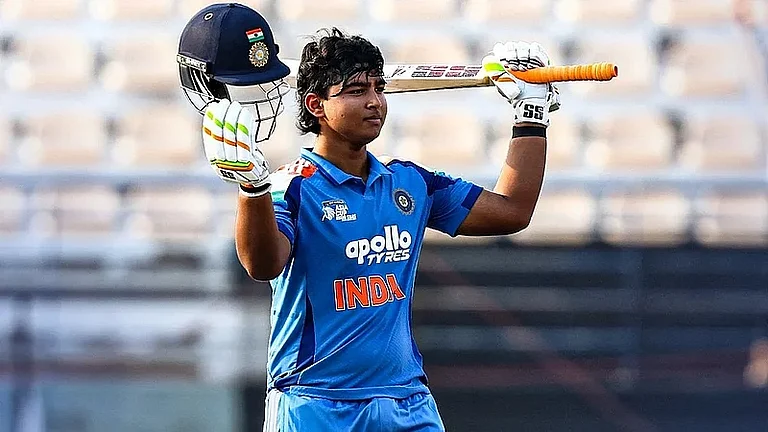
But on Saturday morning, Kashmir isn’t on anybody’s mind in Islamabad. People talk in bated breath about the collapse of Margalla Towers, about the victims trapped under the rubble, the implausibility of finding anyone alive. Others are aghast at the delayed response of rescue operations at the Towers. Laments former minister Husain Haqqani, "Despite the building’s central location, troops arrived after two hours and forty-five minutes with no equipment or training to deal with disaster relief. Compare the army’s reaction to General Pervez Musharraf’s 1999 ouster. Then the army swiftly took control of Islamabad’s key buildings within 35 minutes of Musharraf’s removal from his position as army chief." Subsequently, Haqqani tells a foreign TV channel: imagine a nuclear power possessing just one bulldozer in Islamabad.
It’s a heart-rending sight at the Towers: army personnel and volunteers shovel and claw with bare hands through the debris to take out mangled bodies. The operation gathers momentum only at the arrival of the British Rapid Rescue Squad who possess sophisticated equipment to trace out those still alive under the debris. Nearly 70 hours after 8.50 am, Saturday, the volunteers break into chants of Allah O Akbar as Maha Bibi, 75, and her daughter Khalida Bibi, 55, are pulled out alive.
Islamabad soon overcomes its obsession with itself as the news—and estimates—about the devastation begins to trickle in from various parts of the country.The earthquake has cut a destructive swathe stretching from Muzaffarabad, Balakot and Rawalakot in Kashmir to Manshera, Battagram, Abbottabad, Kohistan and Swat districts in the North West Frontier Province. The reluctance to put a number to the death toll evaporates as intrepid TV journalists make their forays into the disaster zone. The government is compelled to give out its assessment: possibly 40,000 dead, though off-the-record officials say the figure could touch 1,00,000.
The first to hint at the bewildering scale of death in Kashmir is General Shaukat Sultan, DG, inter services public relations. "A whole generation has been wiped out in the area as the maximum number of affected are children. Rescuers are pulling out dead children in Muzaffarabad but there is no one to claim the bodies. Which shows their parents are dead," he says. In Balakot people have stopped counting the dead; about 90 per cent of the houses there had been reduced to rubble. Enveloped in eerie silence, intermittently punctuated by the wail of those alive, the stink of putrefying corpses pervade the air. At least 700 students have been buried alive in three different schools. Azad Kashmir’s prime minister, Sikander Hayat Khan, says he’s "the prime minister of a graveyard, surveying the ruined capital from a tent where I have slept since the weekend". The toll could go beyond 20,000 (in Kashmir alone), he says.

But even this figure would need to be revised upwards as rescue teams wend their way into remote villages. Here those alive have run out of shrouds. They demand not food but sheets of white cloth to wrap the dead in for burial. Here they want to restore to the dead their dignity crushed under the boulders sent rolling down the mountains by the earthquake of October 8.
Does the death toll have to be so high? Japan rocks insouciantly at 7.6 on the Richter; ditto California. Partly, Kashmir’s woes stemmed from its inaccessibility. The two roads from Murree and Abbottabad had been closed because of massive landslides; it took two days to make them motorable, to rush in relief and rescue teams. The government just doesn’t possess enough choppers to tackle disasters of such magnitude.
Some are scathing in their criticism of the US. Couldn’t it have rushed choppers parked in Afghanistan? Washington initially announced assistance of $1,00,000, revising it to $50 million when people pointed out to its niggardly generosity towards an ally committed to the war on terror. And that great ally, Saudi Arabia, couldn’t it have dispatched its impressive fleet of choppers to bolster Pakistan’s rescue operations?
India’s offer of assistance was swift. Sure, New Delhi was scoring brownie points diplomatically. But politicians don’t forget their games even in moments of crisis. President Pervez Musharraf said he needed to look into India’s offer because of "sensitivities" involved, because the affected people were Kashmiris. The media’s criticism of the government’s cussedness compelled it into accepting New Delhi’s offer. The Pakistan People’s Party leader, Aitizaz Ahsan, remarked, "Declining the offer of a strategic arch-rival might have made sense if our allies and brothers like the US and Saudi Arabia were providing the substantive alternatives."
But plane-loads of relief material was not Pakistan’s top priority. It should have instead asked India for assistance in rescue operation, to save those trapped under the rubble. It would have been easier to access Pakistan’s Kashmir from the Indian side, suggest critics who lambast the Pakistan government’s obsession with security. Says Haqqani, "At a time when Pakistan’s own fleet of helicopters appears to be inadequate, the decision to turn down India’s offer of helicopters for relief work reflects a knee-jerk reaction. In the age of satellite imagery, the fear that relief helicopters could be used for espionage is ill-founded. Fears about compromising Pakistan’s political stance over Kashmir by allowing free access across the LoC reflect insecurity."
Politics apart, the earthquake brought to the fore the ills plaguing the construction business. Earthquakes don’t kill, buildings do. This adage acquired new credence as public buildings, like schools and colleges, collapsed under the temblor’s tremble, instantaneously turning these into mounds of death. Prof Akther Naeem, of Peshawar’s University of Engineering and Technology, feels it wasn’t the quake that killed people; ignorance and a careless attitude did. "Seismically designed structures in Kashmir and Hazara districts could have saved thousands of lives," Prof Naeem said, adding that people usually rely for construction on those who are not certified engineers. "Their attitude towards human life is criminal," he said. They use substandard material for construction and flout safety regulations with impunity.
Hammad Husain, a former chairman of the Institute of Architects, blames regulatory authorities like the capital development authorities for the high death toll. "They have been negligent in enforcing proper checks on designs and construction of buildings," Husain said. "The building laws should be reviewed so that greedy developers and callous engineers and contractors are not allowed to put precious human lives at risk." The apartments in the Margalla Towers in Islamabad, for instance, were sold and inhabited even though the developers didn’t possess a completion certificate.
Others pin the blame for the high death toll on the apathy of the rulers (read the Punjab establishment) towards non-Punjabi provinces. For instance, the army considers Kashmir vital to its interests; it has been stationed there for years. Yet its ability to access the region was diminished because of poorly built roads and bridges. Even airstrips to land large transport planes haven’t been built. Critics say the army is prone to treating Kashmir as a garrison, erecting their zones of comfort in a land of abject poverty, indifferent to undertaking development work there.
In the absence of a flourishing economy, you wonder how the Kashmiris will piece together their future. It’s in fact still too early to determine the impact of the earthquake on the country’s economy. Says economic journalist Farhan Bokhari, "It is difficult to say what impact the quake will have on the growth as the factors which push growth, like industry, have not been affected. But the impact will be felt on the budget deficit."
As I write these lines, I hear the clatter of choppers as they fly in the injured from earthquake zones for treatment at the Combined Military Hospital near my house. It’s the sound I have always found unnerving. It’s the sound which would suggest bloody skirmishes at the LoC during the days India and Pakistan hadn’t declared ceasefire; or of military operations as the one conducted in North and South Waziristan earlier this year. Today, the choppers are a grim reminder of nature’s fury, that it had killed more than Pakistan’s wars; of towns and villages in Kashmir—devastated, depopulated, languishing in breathtaking beauty that had turned so cruel and ruthless at 8.50 am on October 8, for a few seconds.





















